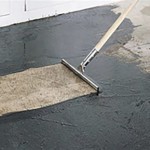How To Lay Ceramic Tile On Cement Floor In Kitchen
Transforming a kitchen with ceramic tile flooring can elevate the space's aesthetics while providing a durable, easy-to-clean surface. Installing ceramic tile on a cement floor is a feasible DIY project for homeowners with some basic construction skills. This comprehensive guide provides step-by-step instructions, essential tools, and tips for achieving a professional-looking result.
Prepare the Cement Floor
A successful tile installation starts with a properly prepared subfloor. If the existing cement floor is uneven, cracked, or has loose areas, addressing these issues is crucial. This involves patching cracks with concrete patching compound, leveling uneven areas with self-leveling cement, and removing loose sections. It's essential to allow the patching compound and self-leveling cement to cure completely before proceeding.
Once the subfloor is smooth and stable, it's important to ensure proper drainage. If the kitchen floor is prone to moisture buildup, install a moisture barrier such as a plastic sheet or a waterproof membrane over the cement floor. This step prevents moisture from seeping through the tiles and causing damage.
Lastly, sweep and clean the floor thoroughly to remove any debris or dust particles that could interfere with the tile adhesive. Apply a primer to the cement floor, allowing it to dry completely before starting the tiling process.
Plan the Tile Layout and Calculate Materials
Before laying any tiles, plan the layout carefully. Consider the size and shape of the kitchen, the placement of existing fixtures, and the overall design aesthetic. A well-planned layout ensures that tile cuts are minimized and that the final installation looks visually appealing.
Create a mock layout using cardboard or paper cut to the size of the tiles. This allows you to experiment with different patterns, determine the best starting point, and visualize the final arrangement. Once satisfied with the layout, calculate the required number of tiles, including allowances for cuts and waste.
Consider the tile size, grout thickness, and any existing features like cabinets or appliances to determine the layout. Aim for a symmetrical pattern and ensure that the spacing between tiles is consistent. Allow for slight variations in the tile size, and remember to take into account the expansion and contraction of materials due to changes in temperature and humidity.
Install the Tiles
With the subfloor prepared and the layout planned, start installing the tiles. This step involves spreading tile adhesive, laying the tiles, and ensuring proper spacing and alignment.
Apply a thin layer of tile adhesive to the subfloor using a notched trowel. The size and shape of the notch should correspond to the size of the tiles being installed. Use a level to ensure that the adhesive is spread evenly.
Place the first tile in the starting position, pressing firmly and ensuring it's level. Use tile spacers to maintain consistent spacing between the tiles. Continue laying the tiles row by row, working your way across the floor.
For cutting tiles, use a wet saw or a tile cutter. Be sure to make clean, precise cuts for a professional finish.
Grout and Seal
Once the tile adhesive has dried, apply grout to fill the spaces between the tiles. Use a grout float to spread the grout evenly, pushing it into the gaps and ensuring a smooth, consistent finish.
After the grout has set, clean the excess grout using a damp sponge. Allow the grout to dry completely, then seal it with a waterproof grout sealer. This step helps prevent water from penetrating the grout, protecting it from staining and discoloration.
Finally, seal the grout and apply a sealant on the tile floor to ensure long-term protection and maintain its shine.
Tile Installation Tips
Here are some additional tips to ensure a successful ceramic tile installation:
- Start the installation in a corner or along a wall.
- Use a rubber mallet to tap the tiles into place.
- Avoid placing any weight on the newly installed tiles for at least 24 hours.
- Keep the installation area well-ventilated while the adhesive and grout are drying.
- Use a level to check the alignment of the tiles frequently during installation.
How To Lay Floor Tiles On Concrete Stonesuper

How To Lay A Tile Floor On Concrete Diy Homeimprovement

How To Tile A Kitchen Floor Step By Guide For Beginners
How To Tile Onto Concrete Floors Porcelain Super
:max_bytes(150000):strip_icc()/can-you-install-tile-directly-on-concrete-1822600-04-458f7bb6c78348c1835cf8054ef36553.jpg?strip=all)
How To Install Tile Over Concrete

Techniques Layout Install Large Format Tiles On Concrete Complete Laying Kitchen

Tiling Over A Ed Concrete Slab Fine Homebuilding

Amazing Techniques Construction Kitchen Floor With Sand Cement How To Install Ceramic Tiles

How To Lay A Tile Floor On Concrete Diy Homeimprovement

Installing Ceramic Tile Over Vinyl Flooring On Concrete 2025 Today S Homeowner
See Also







